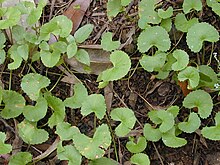Indian pennywort
| Indian pennywort | ||||||||||||
|---|---|---|---|---|---|---|---|---|---|---|---|---|

Tiger grass ( Centella asiatica ) |
||||||||||||
| Systematics | ||||||||||||
|
||||||||||||
| Scientific name | ||||||||||||
| Centella asiatica | ||||||||||||
| ( L. ) Urb. |
The Indian pennywort ( Centella asiatica ) also Asian pennywort , tiger grass or gotu kola is a species of plant in the genus Centella in the umbelliferae family (Apiaceae). The species is used in traditional Chinese medicine and has recently become more common in Europe.
description
The Indian pennywort is a perennial , herbaceous plant . The stem axis is creeping, new roots often grow out of the nodes . The stems are bald or finely hairy .
The leaves are stalked 0.5 to 10 (in extreme cases up to 30) centimeters long. The blades are simple and circular or kidney-shaped . They are between 1–4.5 cm long and 1.5–5 cm wide. The underside of the leaf is covered with small groups of hairs on the leaf veins, the upper side is bare. The leaf margins are wavy . The base is broadly heart-shaped and the edge here roughly serrated. It includes the petiole like a leaf sheath . The venature is palmate with five to seven distinct leaf veins.
The axillary inflorescences sit in groups of two to four umbels on 0.2–1.5 cm long furry or bald inflorescence axes. Two (rarely three) bracts are fused to form a bract . They are egg-shaped and between 3–4 cm long and 2.1–3 cm wide. They do not fall off when the fruit is ripe. The umbels are two- to four-flowered and head-shaped.
The flowers are sessile or almost sessile. The petals are mottled white or pink. Calyx teeth are missing. The ovaries are underneath and purple. The styluses are short.
The fruits are split fruits in two parts . They are between 2.1–3 mm long and 2.2–3.6 mm long. The primary ribs on the fruit are very clear, the secondary ribs form a network structure. The flowering and fruiting time ranges from April to October.
The number of chromosomes is 2n = 18, less often 36 or 54.
The species is relatively similar to Dichondra micrantha Urban from the Convolvulaceae family and is occasionally confused with this species.
distribution
The Indian pennywort is distributed worldwide in the tropics and subtropics and is native to tropical America, Africa, India, West Pakistan, the People's Republic of China, Japan and the Pacific islands. Its original range includes tropical and southern Africa, tropical Asia, China, Korea, Japan, Taiwan, Australia, South America and islands in the northwestern Pacific. It is a neophyte in Norway, the Caucasus, Madagascar and the Seychelles, French Polynesia, Hawaii and the Galapagos Islands.
The species prefers moist to swampy, humus-rich and nutrient-rich locations at altitudes between 200 and 1900 meters. It can often be found on river banks or in rice fields.
ingredients
The plant mainly contains asiaticosides, asiatic acid and madecassic acid as well as other triterpenes saponine , free triterpenes , flavonol glycosides and the alkaloid hydrocotylin . Furthermore, an essential oil can be extracted from the herb that contains caryophyllene , cymene , germacrene and pinene . Overdosing can lead to headache or, in severe cases, to unconsciousness.
Use
The Indian pennywort is used in traditional Chinese medicine and in Ayurvedic medicine in India. It is used there for wound healing, mental disorders and arteriosclerosis . In addition, it should have an antibiotic , antifungal and cytostatic effect.
Since around 2000, plant parts have been increasingly used in Europe and North America by the wellness and cosmetics industries. There, extracts of the herb are said to have been used successfully to tighten and rejuvenate the skin. The French Bayer subsidiary SERDEX has patented five skin care effects of the substance. In particular, a defined combination of the isolated active ingredients Asiatic Acid, Madecassic Acid and Asiaticoside has also been shown to be used successfully to reduce stretch marks or stretch marks.
In a study from 2019 it was shown that an extract from Centella asiatica increases the telomerase production of cells in cell cultures by a factor of 8.8. Centella asiatica could thus play a role in combating aging in the future.
literature
- She Menglan, Mark F. Watson: Centella asiatica . In: Flora of China . tape 14 . Missouri Botanical Garden Press, 2005, ISBN 978-1-930723-41-2 , pp. 18 (English, online [accessed December 3, 2008]).
- E. Nasir: Centella asiatica . In: Flora of Pakistan . tape 20 . University of Karachi, 1972, p. 18 (English, online [accessed December 3, 2008]).
- Cheng-jian Zheng, Lu-ping Qin: Chemical components of Centella asiatica and their bioactivities . In: Journal of Chinese Integrative Medicine / Zhong Xi Yi Jie He Xue Bao . tape 5 , no. 3 , 2007, p. 348-351 , doi : 10.3736 / jcim20070324 .
Web links
Individual evidence
- ^ Tropicos. [1]
- ^ A b Centella in the Germplasm Resources Information Network (GRIN), USDA , ARS , National Genetic Resources Program. National Germplasm Resources Laboratory, Beltsville, Maryland. Retrieved May 1, 2018.
- ↑ Jan Pehrke: Biopirate BAYER. Natural substances as a cheap resource. In: nhrz.de. Neue Rheinische Zeitung, April 20, 2011, accessed on March 27, 2018 .
- ↑ J. Mallol et al .: Prophylaxis of Striae gravidarum with a topical formulation. A double blind trial. In: International Journal of Cosmetic Science . tape 13 , no. 1 , February 1991, p. 51-57 , PMID 19291041 .
- ↑ Dimitris Tsoukalas, Persefoni Fragkiadaki, Anca Oana Docea, Athanasios K. Alegakis, Evangelia Sarandi, Maria Thanasoula, Demetrios A. Spandidos, Aristidis Tsatsakis, Mayya Petrovna Razgonova and Daniela Calina: Discovery of potent telomerase activators: Unfolding. New therapeutic and anti-aging activators: Unfolding perspectives. October 2019, PMC 6755196 (free full text).


